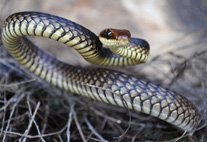Abstract
Two new species of the gobiid genus Coryogalops, C. guttatus sp. nov. and C. pseudomonospilus sp. nov., are described from the Red Sea. Coryogalops guttatus sp. nov. is distinguished from its congeners by having dorsal-fin rays VI + I,12; anal-fin rays I,10–11; pectoral-fin rays 17, three upper rays with free tips; pelvic fins I,5, joined to form a disc, weakly emarginate, with pelvic frenum reduced; longitudinal scale series 33–35; transverse scale rows 9–10; circumpeduncular scales 10–11; seven transverse suborbital rows of sensory papillae on cheek; no tentacle above upper eye margin; anterior nostril tubular, with triangular lappet extending from posterior rim, posterior nostril slightly raised; dark orange spots on many of the scales below body midline form a longitudinal pattern, each spot covering one scale; two distinct dark spots behind edge of preopercle, and similar pair of spots at pectoral-fin base. Coryogalops pseudomonospilus sp. nov. is distinguished from congeners by having dorsal-fin rays VI + I,11; anal-fin rays I,10; pectoral-fin rays 16–17, two upper rays with free tips; pelvic fins I,5, joined to form a disc, moderately emarginate, with pelvic frenum well-developed; longitudinal scale series 33–35; transverse scales rows 9; circumpeduncular scales 12; seven transverse suborbital rows of sensory papillae on cheek; no tentacle above upper eye margin; anterior nostril tubular, without lappet from posterior rim, posterior nostril slightly raised; and irregular dark maroon mark covering lower part of the first three membranes between spines of first dorsal fin. The distribution of species restricted to the western Indian Ocean is discussed, and a key to the species of the genus is provided.

